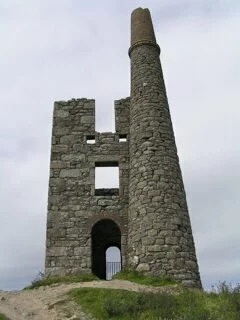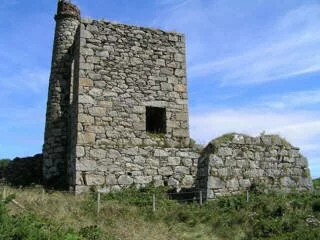Ding Dong Mine, Devon
Penwith: grid reference SW436345
Notable minerals: Chlorite, Fluor, Jasper, Chalcocite & Schorl.

There is thought to have been a mine on this site from ancient times. The present buildings date from its zenith between 1814 and 1878. The most visible parts of the Ding Dong Mine sett to be seen today, are the pumping engine houses over Tredinneck Shaft in the east and Greenburrow Shaft to the west. There are records of the company running five beam engines on its ground in 1840. By 1850 the mine employed about 100 people but the ore was beginning to be worked out in the eastern section causing production to move westwards. The workings of the former Wheal Malkin were reopened with operations centered on Greenburrow shaft.

Greenburrow pumping engine house was erected in 1865 to house a 40-inch cylinder pumping engine, that had previously been in use over North Killiow Shaft. Greenburrow lies on the high moors just to the east of the Madron-Morvah road on Burnt Downs.

Ding Dong Mine's new centre was around Greenburrow Shaft, Bolitho Shaft and the Old Wheal Boys Shaft. About half a mile to the east lay Greenpease shaft and Jacobine shaft. East of these shafts lay the start of the tramway near Croft Reeve, and the site of the Miner's Dry, a whim engine and the ore dressing floors. Over on the eastern side of the sett lay Ishmael's Whim Engine house, Hard Shaft and East Killiow Shaft. Further on, near to the hamlet of Tredinneck lay Providence Shaft and the former Count House, marking the eastern boundary of the tramway. At the end of the decade the mine had expanded its workings to be employing over 200 workers. The workforce rose to its maximum of over 250 men and boys by the 1870's, but the company was finding it more and more difficult to balance the books.
Alluvial tin discovered in Queensland, Australia in the mid 1870's led to a glut of world tin, depressing the tin price. Many Cornish mines were now not viable to keep running. The company decided to offer the mine for sale at auction in 1877. Unfortunately, the mine could not be sold and so finally shut down in May 1877. Several attempts have been made to reopen the mine since then but sadly these have all come to nothing.
Other nearby mines and their main ores
South Hooe (approx. 103.2 km; LEAD, SILVER & FLUORSPAR)
Park Valley (approx. 103.5 km; SILVER-LEAD)
North Hooe (approx. 103.9 km; LEAD & ZINC)
South Tamar (approx. 104.3 km; LEAD, SILVER & FLUORITE)
Ward Mines (approx. 104.8 km; LEAD & SILVER)
Capunda (approx. 104.8 km; COPPER & LEAD)
Devon Great United (approx. 105.0 km; COPPER,LEAD & ARSENIC)
Lockridge Mine (approx. 105.0 km; LEAD, FLUORITE & SPHALERITE)
Frementor (approx. 105.4 km; COPPER)
Tamar Valley (approx. 105.4 km; LEAD, SILVER, PYRITE & FLUORSPAR)
Mining Database
Maps
Be safe and prepared with the latest maps from the Ordnance Survey